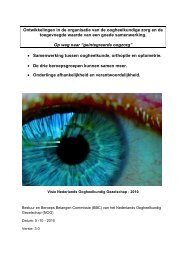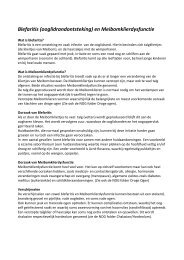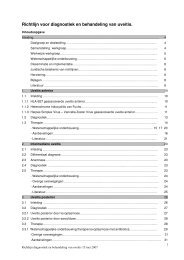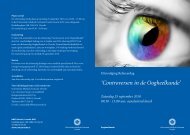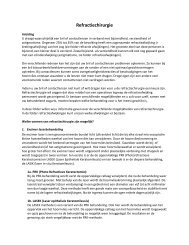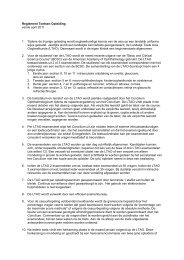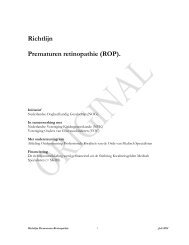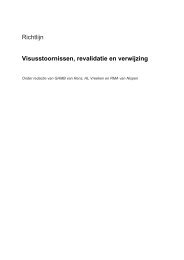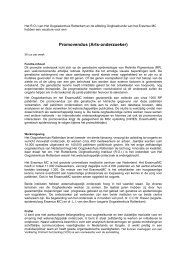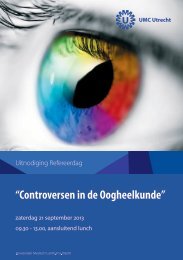terminology and guidelines for glaucoma ii - Kwaliteitskoepel
terminology and guidelines for glaucoma ii - Kwaliteitskoepel
terminology and guidelines for glaucoma ii - Kwaliteitskoepel
Create successful ePaper yourself
Turn your PDF publications into a flip-book with our unique Google optimized e-Paper software.
The advantage of this classification is that it is simple <strong>and</strong> immediately underst<strong>and</strong>able; disadvantages are that it is quite<br />
subjective <strong>and</strong> not very reproducible, because it is largely based on personal experience in evaluating the visual field.<br />
Manual perimetry is used less <strong>and</strong> less nowadays.<br />
Grading based on number <strong>and</strong> depth of defect points<br />
The Advanced Glaucoma Intervention Study (AGIS) investigators proposed a classification where the VF defect score<br />
is based on the number <strong>and</strong> depth of clusters of adjacent depressed test sites in the upper <strong>and</strong> lower hemifields <strong>and</strong> in<br />
the nasal area of the total deviation print out (Statpac 2 analysis) 19 . The score ranges from 0 (no defect) to 20 (all test<br />
sites deeply depressed). This scoring system is accurate. For routine use however it might be too elaborate. Langerhorst<br />
using scoperimeter (experimental perimeter) data suggested a classification in five stages 20 . This type of classification<br />
can be adapted to st<strong>and</strong>ard full threshold programs, like Humphrey 30-2 or Octopus G1.<br />
Esterman grids<br />
Esterman proposed a visual field defect quantification system, using a 100 sector grid, denser in the central <strong>and</strong> inferior<br />
area of the visual field 21 . This grid must be superimposed on VF, in order to obtain a score showing VF functional state.<br />
Drawback of this method is that it only applies to supraliminal strategies <strong>and</strong> is not useful in <strong>glaucoma</strong> staging.<br />
This classification was modified <strong>for</strong> threshold strategies in order to obtain more in<strong>for</strong>mation on functional status.<br />
Classification based on perimetric indices<br />
Perimetric indices were proposed first by Flammer <strong>for</strong> Octopus perimeters <strong>and</strong> are available also <strong>for</strong> the majority of<br />
other instruments 9 . The most revelant indices are mean sensitivity (MS), mean deviation or mean defect (MD), loss<br />
variance (LV), pattern st<strong>and</strong>ard deviation (PSD), short-term fluctuation (SF), corrected loss variance (CLV), corrected<br />
pattern st<strong>and</strong>ard deviation (CPSD). Various indices can be used to stage <strong>glaucoma</strong>tous damage.<br />
It was noted that CLV was elevated in the first phases of <strong>glaucoma</strong> <strong>and</strong> the elevated level of CLV did not vary with<br />
increasing field loss as indicated by MD 24 . A classification system <strong>for</strong> defining stages of <strong>glaucoma</strong> was proposed utilizing<br />
CLV <strong>and</strong> MD as a combined index. CLV was shown to be sensitive to early stages of <strong>glaucoma</strong> damage, subsequently<br />
becoming stable.<br />
MD was shown to be sensitive to progression of field loss, but not useful <strong>for</strong> early detection. It may be advantageous<br />
to combine these two field indices in order to achieve a more comprehensive picture of field loss in <strong>glaucoma</strong>.<br />
Brusini proposed a staging system using MD, CLV <strong>and</strong> CPSD 25,26 . This method requires the use of specific charts.<br />
It is very rapid <strong>and</strong> practical <strong>for</strong> clinical use, <strong>and</strong> it is gaining popularity. It allows to grade the severity <strong>and</strong> the type of<br />
the defect, but is not specific <strong>for</strong> <strong>glaucoma</strong>.<br />
Staging based on Statpac box-plot<br />
Shin <strong>and</strong> co-workers developed a system <strong>for</strong> classification of <strong>glaucoma</strong>tous VF defects by means of numerical values 27 .<br />
The visual fields were represented by Humphrey Box-plots <strong>and</strong> were classified by the minimum, the lower limit of the<br />
box <strong>and</strong> the median.<br />
The VF defect can be classified into five major stages <strong>and</strong> five minor groups. This method objectively represents the<br />
extent of the VF defects, but does not indicate the type.<br />
Glaucoma change probability analysis (Statpac 2 - Humphrey)<br />
This program allows selection of two early visual field tests as baseline. Subsequent visual fields are directly compared<br />
to this baseline. Significant change from baseline in the measured threshold at any location is determined by comparison<br />
with reference database of visual fields from stable <strong>glaucoma</strong> subjects. This probability analysis has been shown to<br />
correlate well with routine clinical evaluation of progression of visual field changes 28 .<br />
Progressor (Pointwise linear regression analysis)<br />
All the luminance sensitivity measurements are analyzed by linear regression that generates a slope at each location<br />
with a positive or negative sign <strong>and</strong> a p value 29,30 .<br />
An excellent test <strong>for</strong> longitudinal follow-up. It requires proprietary software.<br />
Please note: none of the grading systems is specific <strong>for</strong> <strong>glaucoma</strong>.<br />
Ch. 1 - 28 EGS



